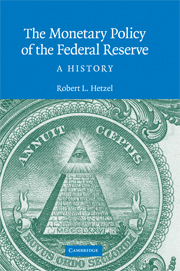Book contents
- Frontmatter
- Contents
- Figures
- Preface
- 1 The Pragmatic Evolution of the Monetary Standard
- 2 Learning and Policy Ambiguity
- 3 From Gold to Fiat Money
- 4 From World War II to the Accord
- 5 Martin and Lean-against-the-Wind
- 6 Inflation Is a Nonmonetary Phenomenon
- 7 The Start of the Great Inflation
- 8 Arthur Burns and Richard Nixon
- 9 Bretton Woods
- 10 Policy in the Ford Administration
- 11 Carter, Burns, and Miller
- 12 The Political Economy of Inflation
- 13 The Volcker Disinflation
- 14 Monetary Policy after the Disinflation
- 15 Greenspan's Move to Price Stability
- 16 International Bailouts and Moral Hazard
- 17 Monetary Policy Becomes Expansionary
- 18 Departing from the Standard Procedures
- 19 Boom and Bust: 1997 to 2001
- 20 Backing Off from Price Stability
- 21 The Volcker–Greenspan Regime
- 22 The Fed: Inflation Fighter or Inflation Creator?
- 23 The Stop–Go Laboratory
- 24 Stop–Go and Interest Rate Inertia
- 25 Monetary Nonneutrality in the Stop–Go Era
- 26 A Century of Monetary Experiments
- Appendix: Data Seen by FOMC for the Stop–Go Period Shown in Figures 24.1, 24.2, and 24.3
- Notes
- Bibliography
- Index
- Titles in the series
5 - Martin and Lean-against-the-Wind
Published online by Cambridge University Press: 26 May 2010
- Frontmatter
- Contents
- Figures
- Preface
- 1 The Pragmatic Evolution of the Monetary Standard
- 2 Learning and Policy Ambiguity
- 3 From Gold to Fiat Money
- 4 From World War II to the Accord
- 5 Martin and Lean-against-the-Wind
- 6 Inflation Is a Nonmonetary Phenomenon
- 7 The Start of the Great Inflation
- 8 Arthur Burns and Richard Nixon
- 9 Bretton Woods
- 10 Policy in the Ford Administration
- 11 Carter, Burns, and Miller
- 12 The Political Economy of Inflation
- 13 The Volcker Disinflation
- 14 Monetary Policy after the Disinflation
- 15 Greenspan's Move to Price Stability
- 16 International Bailouts and Moral Hazard
- 17 Monetary Policy Becomes Expansionary
- 18 Departing from the Standard Procedures
- 19 Boom and Bust: 1997 to 2001
- 20 Backing Off from Price Stability
- 21 The Volcker–Greenspan Regime
- 22 The Fed: Inflation Fighter or Inflation Creator?
- 23 The Stop–Go Laboratory
- 24 Stop–Go and Interest Rate Inertia
- 25 Monetary Nonneutrality in the Stop–Go Era
- 26 A Century of Monetary Experiments
- Appendix: Data Seen by FOMC for the Stop–Go Period Shown in Figures 24.1, 24.2, and 24.3
- Notes
- Bibliography
- Index
- Titles in the series
Summary
After the 1951 accord and through the mid 1960s, approximate price stability prevailed. What produced this stability?
From Real Bills to Lean-Against-the-Wind
After World War II, policymakers stopped viewing recessions as the inevitable reaction to prior speculative excess. Also, they began to see inflation as a consequence of excess aggregate demand rather than speculative excess. The rise in the price level with the end of wartime price controls and its subsequent failure to fall forced that change. Such inflation could not arise from asset speculation. As FOMC Chairman Eccles (Board of Governors Board Minutes November 18, 1947, 1575) reasoned, “Even loans for productive purposes are inflationary if they increase the demand for labor and material that are already in short supply.”
The intensification of the Korean War in fall 1950 produced a surge in expenditure and inflation (Figure 5.1). If maintained, the Fed's interest rate peg would have sustained inflation through the monetization of government debt. That experience made clear to the Fed the importance of allowing the central bank, rather than private markets, to control reserves creation. Like World War II, that experience also moved the Fed toward thinking about inflation as resulting from excess aggregate demand rather than speculation.
The accord was a watershed for the Fed. The ideal of a central bank that allows an “elastic currency” passively to “accommodate commerce” disappeared. The Fed moved toward the idea of manipulating short-term interest rates to control aggregate demand and inflation.
- Type
- Chapter
- Information
- The Monetary Policy of the Federal ReserveA History, pp. 49 - 59Publisher: Cambridge University PressPrint publication year: 2008

